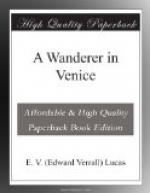Returning to Room X in the main sequence we find wood-carving and pottery. In Room XI, just inside the door on the left, is a noble gondola prow in iron, richly wrought, which one would like to see on a boat once more. Room XII has glass and porcelain; Room XIII has ivories and caskets; and Room XIV has illuminated manuscripts, in one of which, No. 158, is a very attractive tiny little Annunciation; and so we come again to the pictures, in Rooms XV and XVI of which the second contains the pick. But there is little to cause the heart to beat any faster.
A quaint and ugly but fascinating thing, attributed to Carpaccio and said to represent two courtesans at home, is the most memorable. Why it should not equally represent two ladies of unimpeachable character, I cannot see. Ruskin went beyond everything in his praises, in St. Mark’s Rest, of this picture. He suggests that it is the best picture in the world. But read his amazing words. “I know,” he says, “no other which unites every nameable quality of painter’s art in so intense a degree—breadth with tenderness, brilliancy with quietness, decision with minuteness, colour with light and shade: all that is faithfullest in Holland, fancifullest in Venice, severest in Florence, naturalest in England. Whatever de Hooghe could do in shade, Van Eyck in detail, Giorgione in mass, Titian in colour, Bewick and Landseer in animal life, is here at once; and I know no other picture in the world which can be compared with it.”
In the same room is a figure of Christ mourned by two little angels, ascribed to Giovanni Bellini, but bearing Durer’s monogram.
On the stairs are historical Venetian scenes of fires, fights, and ceremonials which we shall find in more abundance at the Querini Stampalia. The top floor is given to Canova, Canaletto, Guardi, and Tiepolo, and is very rich in their drawings and studies. In Canova I find it impossible to be much interested, but the pencil work of the others is often exquisite. From some of Canaletto’s exact architectural drawings the Venice of his day could be reconstructed almost stone by stone.
Before leaving the Museo Civico let me warn the reader that it is by no means easy of access except in a gondola. Two steamboat stations pretend to deposit you there, but neither does so: S. Stae, from which it is a tortuous walk, and S. Marcuola, on the other side of the Canal, which means a ferry boat.
There is a calle and a traghetto next the museum, and then a disreputable but picturesque brown house with a fondamenta, and then the home of the Teodoro Correr who formed the nucleus of the museum which we have just seen and left it to Venice. His house is now deserted and miserable. A police station comes next; then a decayed house; and then the Palazzo Giovanelli, boarded up and forlorn, but not the one which contains the famous Giorgione. And here, at the nice garden on the other side of the Rio S. Giovanni Decollato, I think, we may cease to identify the buildings, for nothing else is important.




